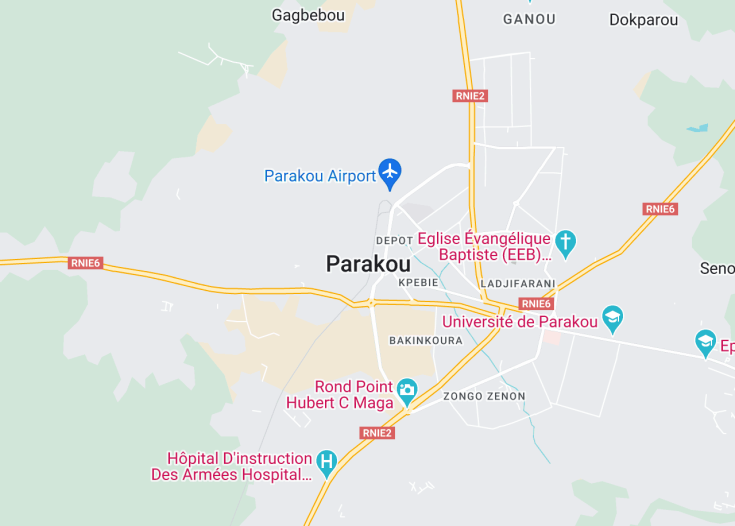Parakou, the crossroads of Benin, offers travelers a blend of urban dynamism and traditional charm. As the country’s third-largest city, Parakou is vital for commerce and acts as a cultural melting pot. Its bustling markets, diverse ethnic groups, and rich history extending back to its role in the trans-Saharan trade make it a fascinating destination. Visitors will enjoy exploring its varied local cuisine, vibrant arts scene, and nearby natural attractions, including the W National Park just a few hours’ drive away.
Ensure to visit the Parakou Market, renowned for its textiles and local handicrafts. It’s an excellent place for discovering unique souvenirs and gifts.
Plan your visit during the cooler months, from November to February, to enjoy the city’s offerings comfortably under milder weather conditions.
Top things to do & see in Parakou
Select the following sights and activities to discover best tickets and tours available in Parakou.
Explore Parakou: A Hub of Tradition and Progress
| Country | Benin |
| Time in Parakou | GMT+1 |
| Language spoken | French |
| Population | 255,478 (World Population Review, 2023) |
| Currency | West African CFA franc (XOF ₣) |
| Airports | Tourou Airport (10 mi / 16 km). |
Parakou, located in the Borgou Department, is the second-largest city in Benin and serves as a significant trade center and rail hub. This radiant city not only connects several major cities through its extensive railway network but also exudes a rich blend of culture and development. Parakou’s history stretches back to when it was a small settlement and has witnessed immense growth over the years, evolving into a bustling urban area.
Where is Parakou?
Positioned in the heart of Benin, Parakou is a key city in the northern part of the country, serving as a crucial crossroad in regional commerce.
Distances:
| Route | Distance by car | Time by car |
|---|---|---|
| Cotonou to Parakou | 261 miles (420 km) | Approx. 6 hours |
| Porto-Novo to Parakou | 275 miles (442 km) | Approx. 6 hours 30 min |
| Natitingou to Parakou | 135 miles (217 km) | Approx. 3 hours 15 min |
What is Parakou famous for?
Parakou is renowned for its vibrant market scenes and the art of trade. It acts as a confluence point for traders from the north and south. Its markets are a colorful display of fabric, food, and artwork, drawing in both locals and tourists alike.
History
The story of Parakou, located in central Benin in the Borgou Department, is deeply entwined with the history and culture of the region. The city’s origins and its journey through time highlight its significant role in the region.
Pre-Colonial Era (Before 18th Century)
Before becoming the city it is today, the region around Parakou was primarily inhabited by various indigenous groups, predominantly the Bariba and Fulani peoples. These communities engaged in subsistence farming, hunting, and later, trading activities, laying the foundational social and economic structures of the area.
Colonial Period (18th Century – 1960)
During the late 18th century, Parakou began to gain prominence as a major trading center within the trans-Saharan trade routes. The arrival of French colonial forces in the late 19th century further transformed Parakou, integrating it into the colonial economy. The French developed infrastructure to facilitate the export of raw materials, notably cotton and groundnuts, which significantly altered local economies and social structures.
Post-Independence Era (1960 – Present)
Since Benin gained independence in 1960, Parakou has continued to develop and expand. It became an important administrative and economic center. The establishment of educational institutions, including the University of Parakou, and improvements to the transport infrastructure, such as the railway connecting to Cotonou, have been crucial in its development. The city has also been a driving force in Benin’s political and cultural spheres, contributing to the broader national discourse.
Visit Parakou
What to see and do in Parakou, Benin.
Parakou offers a range of activities and sites for visitors:
- Explore the Parakou Market, a vibrant hub for local commerce and culture, offering a variety of goods from traditional crafts to local foods.
- Visit the Musée en Plein Air de Parakou, an open-air museum that showcases traditional Beninese architecture and art.
- Experience the Grand Mosque of Parakou, a focal point of the city’s Islamic heritage.
- Relax at Parakou Municipal Gardens, a serene environment ideal for leisure and reflection.
Festivals in Parakou
Parakou hosts several cultural events and festivals throughout the year, each bringing a unique flavor and experience. Notable events include the Parakou International Film Festival, occurring in early December, and the annual Voodoo Festival in January, which showcases the area’s rich religious traditions and practices.
Best time to visit Parakou
The best time to visit Parakou is during the cooler, dry months from November to February. This period offers more comfortable weather conditions, making it ideal for exploring the city and participating in outdoor activities and festivals.
Is Parakou worth visiting?
Parakou is a city with a rich history and vibrant cultural scene, making it worth a visit for those interested in exploring more of Benin beyond the usual tourist destinations. However, it’s important to note that the city’s attractions might not appeal to all travelers, as they are deeply rooted in local culture and tradition. The infrastructural amenities may also not meet international standards. Nonetheless, for those seeking an authentic Beninese experience and a glimpse into the country’s inland urban life, Parakou offers a compelling and enriching experience.










